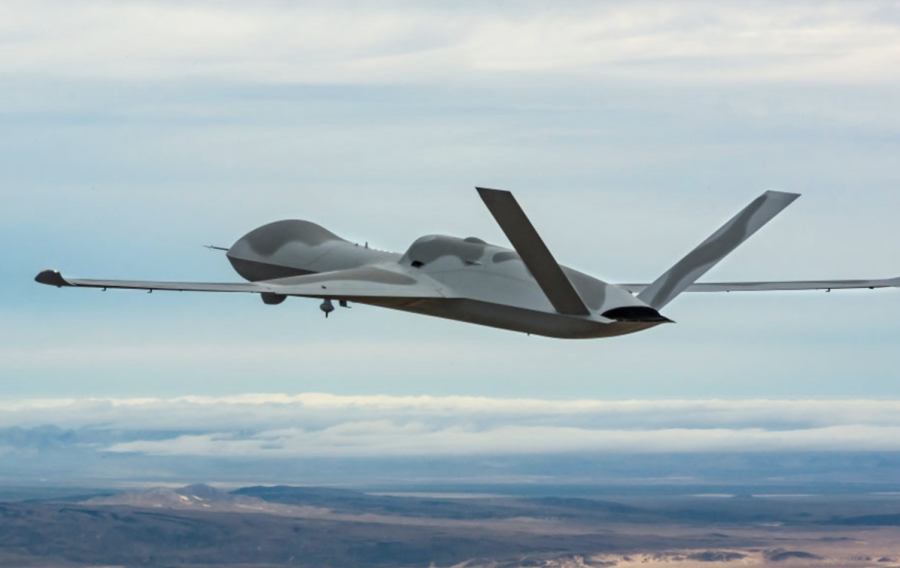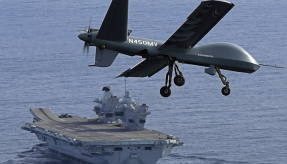
General Atomics Aeronautical Systems, Inc. (GA-ASI) demonstrated its rapidly maturing open standards-based autonomy ecosystem for Unmanned Combat Air Vehicles (UCAVs) on an MQ-20 Avenger as part of a live flight test on Nov. 2, 2023.
The flight combined three autonomy providers, government-provided human-machine interface (HMI) hardware, and GA-ASI’s autonomy core to meet multiple objectives for collaborative combat missions and closed the Find, Fix, Track, Target, Engage, and Assess (F2T2EA) engagement chain using a mix of Live, Virtual, and Constructive (LVC) entities.
The flight, which took place from GA-ASI’s Desert Horizon Flight Operations Facility in El Mirage, Calif., illustrates the company’s commitment to maturing its open standards-based autonomy software ecosystem for Autonomous Collaborative Platforms (ACPs).
Designing the system around government-owned and -maintained standards avoids vendor lock and allows rapid integration of best-of-breed capabilities in areas such as Artificial Intelligence (AI), HMIs, and other skills from third-party providers.
“This flight underscores GA-ASI’s commitment to proving combat operational readiness for vendor-agnostic autonomy architecture for UCAV platforms,” said GA-ASI Vice President of Advanced Programs Michael Atwood. “Ultimately, GA-ASI’s series of flight tests demonstrate our unmatched ability to deploy best-of-breed mission software, autonomy, and hardware capabilities on unmanned platforms, accelerating the operationalization of this critical technology for the warfighter. This most recent test shows multi-service compatibility of the autonomy core through the integration of USAF and Navy software skills together.”
Another important goal of GA-ASI’s flights is to demonstrate the company’s commitment to developing an open government standards-based autonomy ecosystem that enables rapid integration and validation of third-party tactical software applications.
GA-ASI is focused on supporting the emerging App Store-based model that allows organizations to rapidly develop and deploy software while maintaining safety of flight and ensuring warfighters have up-to-date access to the industry’s best capabilities.
Autonomy skills for the recent flight test were provided by GA-ASI, Scientific Systems Company, Inc. (SSCI), and NAVAIR PMA-281’s ARCANE (Architecture and Capabilities for Autonomy in Naval Enterprise) Team. The PMA-281 ARCANE Team accomplishes Intelligent Autonomy & AI integration, compliance, and sustainment objectives for Naval Aviation UAV Tactical Operations.
Different skills on the aircraft were activated based on the F2T2EA phase or via human-on-the-loop interaction using the FOX tablet HMI.
A government-furnished autonomy core and Open Mission Systems (OMS) messaging protocols were used to coordinate between provider skills during different F2T2EA phases. Rapid integration of these disparate skills was made possible by utilizing government standards, such as OMS, and adhering to state-of-the-art government autonomy design methods.
Collaborative mission autonomy capabilities provided by SSCI successfully commanded a fully autonomous multi-vehicle Defensive Counter Air (DCA) mission—from Combat Air Patrol (CAP) through detection, identification, tracking, and multiple successful engagements.
“Our Collaborative Mission Autonomy (CMA) development kit enables the team to perform development and integration in short time frames in a tactically relevant way,” said David “Heat” Lyons, SSCI’s Vice President of Business Development and former F-16 Weapons Officer and combat fighter pilot. “For the warfighter, we are demonstrating mission-ready behaviors on GA-ASI’s UCAV that are trustworthy, understandable, and explainable.”
GA-ASI provided weapon-target pairing (WTP) and electronic warfare (EW) autonomy skills for the flight. These were developed using GA-ASI’s deep reinforcement learning (RL) framework.
The mission skills were activated like play calls in real time, and their status was monitored by the pilot via the FOX tablet.
NAVAIR PMA-281’s ARCANE program delivered a cooperative weave skill, whereby a live lead MQ-20 was paired with a simulated follower MQ-20 to demonstrate a collaborative flight formation technique aimed at increasing survivability.
This demonstration showcased the flexibility of GA-ASI’s autonomy core to rapidly integrate third-party best-of-breed skills in support of a wide range of evolving mission types.
Collectively, these skills were integrated into and orchestrated by the government-furnished autonomy core architecture that was enhanced by GA-ASI.
The flexibility of the government managed autonomy core software stack enabled rapid and seamless integration of multi-UAS third-party behaviors.
If you would like to join our community and read more articles like this then please click here







